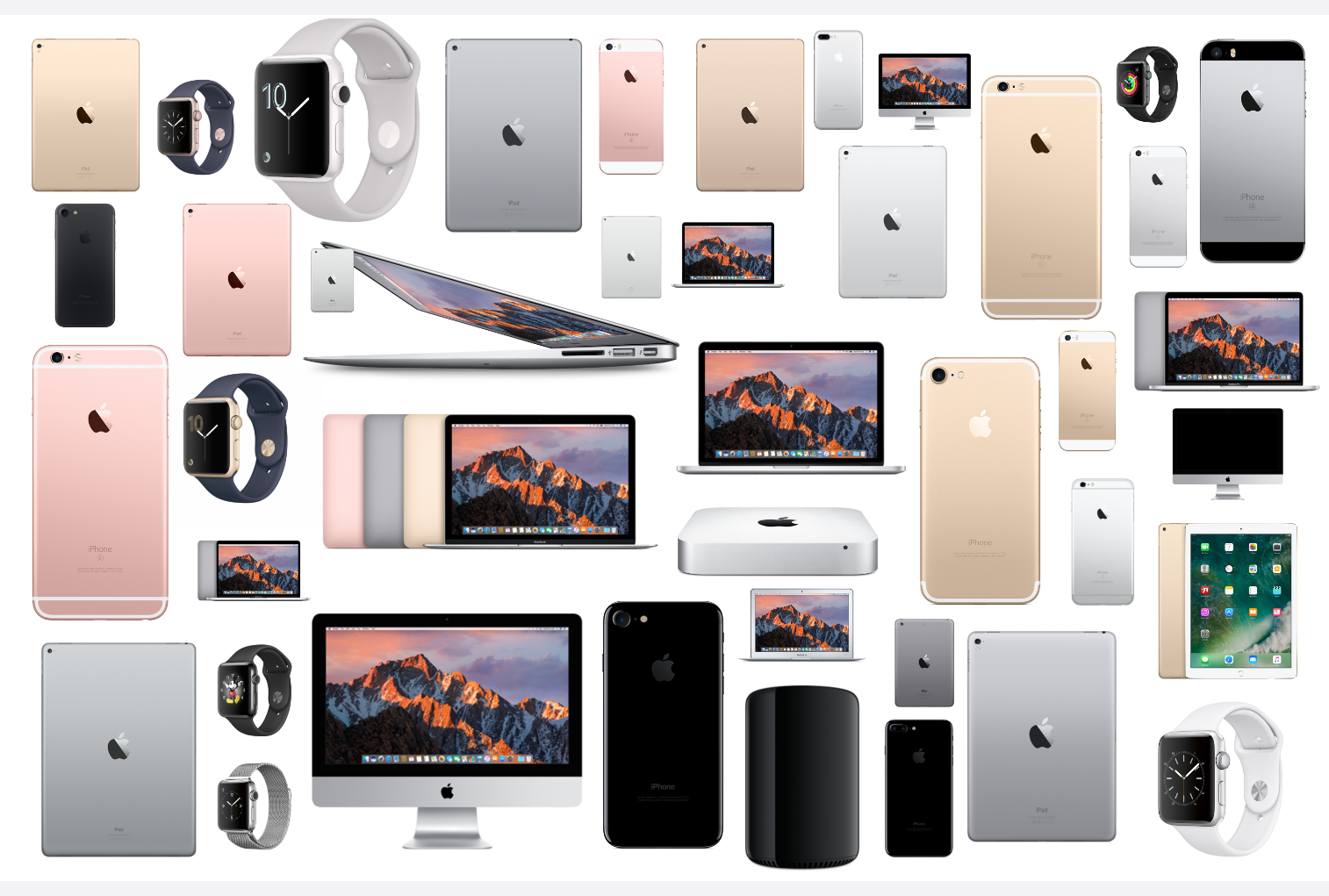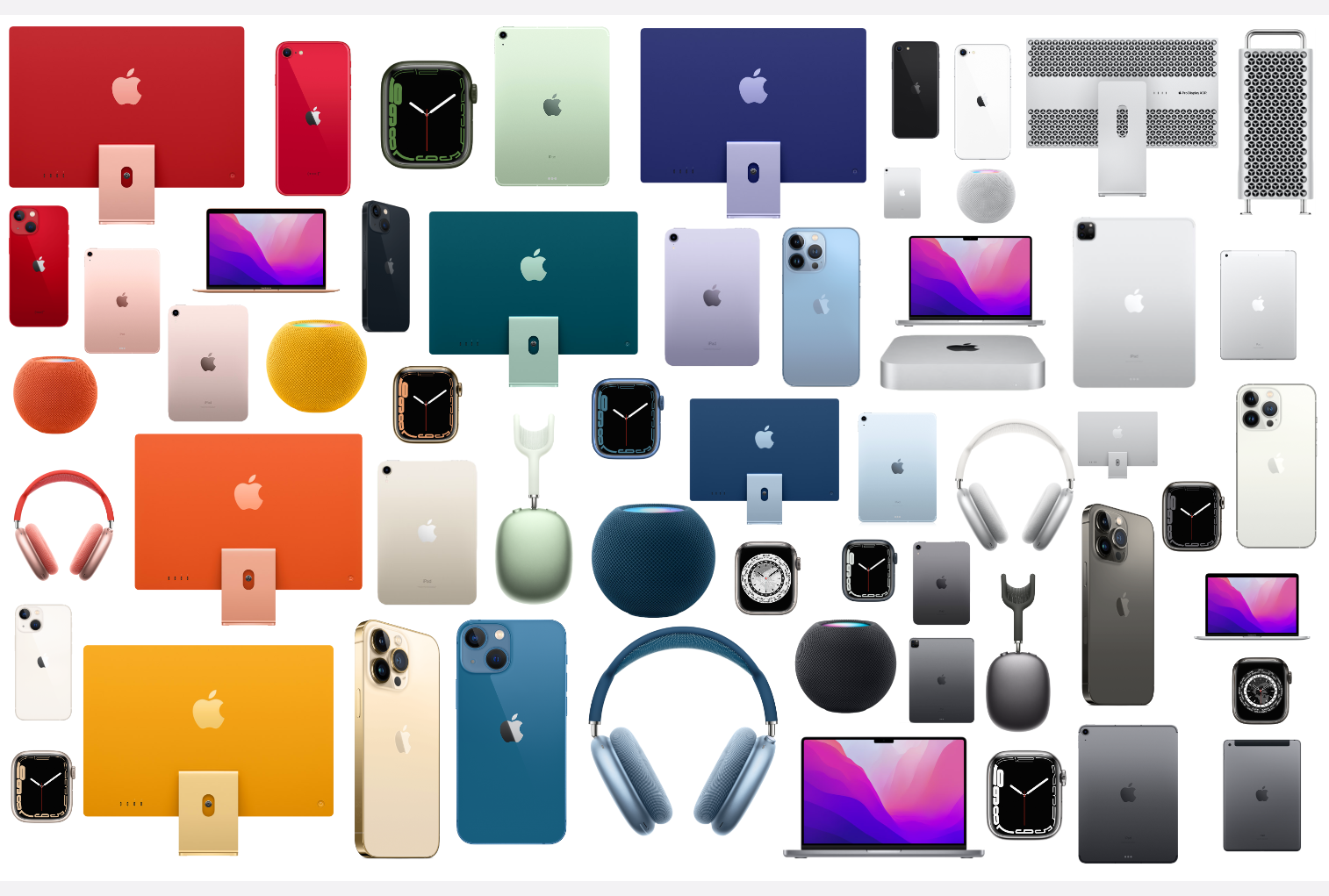Colour Chaos
In half a decade, Apple products have gone from only a handful of colour staples to dozens of bold shades and finishes.
This entry begins five years ago... The year was 2016. The TouchBar MacBook Pro had just been released, the iPhone 7 had just launched, the AirPods were still on the horizon, and Apple's colour lineup was far different than it is today.
In 2016 you could have any colour you wanted as long as it was Silver, Space Grey, Gold, or if you’re lucky, Rose Gold.
Of Apple's Mac offerings, The new MacBook Pros & 12" MacBook came in Silver & Space Grey, while The iMac, Mac mini, & 13" MacBook Air came in only Silver. The Mac Pro had an exclusive Space Black polished steel finish, and the 12" MacBook was the only Mac to come in two additional finishes: Gold and Rose Gold.
The iPad lineup offered Silver and Space Grey finishes across the line, including the 12.9" Pro, 9.7" Pro, Air 2, mini 4, and mini 2. The Pros, Air 2, and mini 4 had a third colour option, gold, and the 9.7" Pro came in a fourth Rose Gold finish.
On the iPhone, in addition to Silver, Gold, and Rose Gold across all five phones, your choices were Jet Black or Black in the new iPhone 7 & 7 Plus, or Space Grey in the 6S, 6S Plus & iPhone SE.
Finally, on the Apple Watch, Silver, Space Grey, Gold, & Rose Gold were your Aluminium options, White ceramic for the edition, and Silver & Space Black were your Stainless Steel options.
All of that to say that in 2016, Apple's entire lineup consisted of a total of nine colour options. Fast forward to the end of 2021, there are now, by my count, 49 different colour options across Apple's lineup:
Seven iMac colour finishes
Blue, Green, Orange, Pink, Purple, Silver, & Yellow
Three MacBook colour options
Silver, Space Grey, & Gold
Eight iPad finishes
Green, Pink, Purple, Rose Gold, Silver, Space Grey, Sky Blue, & Starlight
Eleven iPhone colours
Black, Blue, Gold, Graphite, Midnight, Pink, Product(RED), Sierra Blue, Silver, Starlight, & White
Eleven Apple Watch finishes
Blue, Gold (Stainless Steel/Aluminium), Graphite, Green, Midnight, Product(RED), Silver (Stainless Steel/Aluminium), Space Black Titanium, Space Grey, Starlight, & Titanium.
Five AirPod Max options, and;
Green, Pink, Silver, Space Grey, & Sky Blue.
Five shades of Apple's HomePod mini
Blue, Orange, Space Grey, White, & Yellow.
And after accounting for duplicate colours (for example, Silver in the iMac, iPad, AirPods Max, & Apple Watch SE), there are still nearly 30 unique colour's across Apple's product lineup¹. Keep in mind, this doesn't include the older iPhone 12 and 11 colours (which consists of 2 different shades of Purple, Product(RED), & Green), Blue, Yellow, Black, and White), all of which Apple still sells.
Apple’s 2021 lineup includes an explosion of colour across many of their product categories.
There are more colour options than ever before across Apple's products, and a refresh cycle sees colours regularly announced and discontinued annually. In a recent post comparing these two years, I received many comments strongly favouring one year over the other. Many applauded Apple's current colour options for bringing more fun and personalization to the line; others despised the current trend for its lack of consistency and coherence across products. People could only agree that Jony Ive was somehow responsible for suppressing Apple's colour options which appear to be liberated after his departure.
Colour as Personalization
But before anyone says "Steve would never...", these past few years of colour experimentation aren't by any means new to Apple. The iMac famously came in numerous bold colours & prints, including the infamous Flower Power and Blue Dalmatian iMac. And while most of Apple's Macs during the 2000s stuck with white plastic and silver aluminum bodies, the iPod became a testbed of colour experimentation. Apple would annually release a mini or nano in an increasing variety of colour finishes. The benefit to Apple was probably a nice kickback in sales. The benefit to customers were products that felt more like an extension of their personality, aesthetics, or preferences than ever before. More than once, I have been loured to update a product sooner than I may have wanted or needed to because I fell in love with a colour option available.
Personalization is not a trivial matter. Technology can often be designed to look very cold & utilitarian. But intentional design considerations and the infusion of colours can help make devices feel more welcoming and at home in our environments. The new iMac is an excellent example of this - the soft grey borders of the bezel are more likely to blend into the colour of many living spaces, and a soft pastel-coloured chin can serve to match decor or serve as an accent piece of its own. And all specs being equal, people still chose to wait longer for a specific iMac colour because they felt that it matched their aesthetic or reflected their brand or personality best.
Current Cost: Consistency
As much as I love my Blue iMac & Starlight iPad mini, there's a part of my very Type-A brain that struggles with the inconsistency that's developed across the line. While Silver is available on most products, the mini 6 & Apple Watch Series only comes in Starlight. And while there are blue product options in many of Apple's products, the blue of the iMac compared to the iPhone, compared to the Apple Watch, AirPods Max & iPad Air are all different.
The Series 7 Apple Watch, iPad Air 4/AirPods Max, iPhone 13, HomePod mini, and 23.5” iMac all come in different shades of blue.
What's emerged is an assortment of colours that are not consistent (e.g. Pink on the iMac, iPhone 13, & iPad mini are all different), not available across all products, and often updated at various intervals to one another. For example, the new Midnight colour option is available on the iPhone 13 & Series 7 Apple Watch, but not in Apple's recent Macs or iPads. And despite the mini being announced when new colours were debuted, it only got the new Starlight colour and retained the more traditional Space Grey colouring. Whereas in 2016, you reliably had 2-3 shared colours across the range of Apple products, this is no longer the case.
In Sum
A compromise that could partially alleviate the situation would be having a stable base of 3-4 of the most popular colour options that span the broadest reach of products. Then, releasing 2-3 seasonal colours debuting across the lineup, lasting a generation or two before being refreshed. This would cap the range of colours to a stable palette that rotates every several years while also giving customers the option of a few consistent colour choices to build around beyond just Silver and Space Grey.
At the moment, I welcome Apple's shift to a broader colour palette while criticizing it for feeling a bit too chaotic for my tastes. What appealed to me about 2016 was the coherence of colour across product categories. In contrast, now the lineup risks feeling disjointed by the variety of colour options, a problem that'll be exacerbated if massive amounts of new colours continue to be rolled out annually across Apple's lineup. But all this may just be growing pains as Apple shifts to a more vibrant vision for its products, a change I very much welcome.
¹Those unique colours include: 1. Pad Air/AirPods Max Green, 2. Apple Watch Green, 3. iMac Green, 4. iMac Purple, 5. iPad mini Purple, 6. iPad Air Rose Gold, 7. iPad mini Pink, 8. AirPods Max Pink, 9. iPhone 13 Pink, 10. iMac Blue, 11. iPad Air/AirPods Max Sky Blue, 12. iPhone 13 Blue, 13. iPhone 13 Pro Sierra Blue, 14. HomePod mini Blue, 15. Apple Watch Blue, 16. iPhone SE White, 17. iPad mini/Apple Watch Starlight, 18. iPhone 13/Apple Watch Midnight, 19, iPhone SE/iPhone 13 Product(RED), 20. iPhone 13 Pro/Apple Watch Gold, 21. iPhone 13 Pro/Apple Watch Graphite, 22. iPhone 13 Pro/Apple Watch Silver, 23. Apple Watch SE Gold, 24. Apple Watch Titanium, 25. Apple Watch Space Black Titanium, 26. All the different Silver Apple Products, 27. All the different Space Grey Apple Products, 28. iMac Orange/HomePod mini Orange, 29. iMac Yellow/HomePod mini Yellow.




